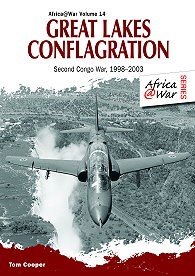
- aviationmegastore.com
- Ship to United States
Quick Search
Aviation Shop
categoriesPublic holidays
Amended or confirmed operating hours of the Luchtvaart Hobby Shop in Aalsmeerderbrug on the following dates:
Aviation Megastore website is available without limitations. Orders are processed during shop operating hours.
| Tu | 24 Dec. | Open 10-15 hrs |
| We | 25 Dec. | Closed: Christmas |
| Th | 26 Dec. | Closed: Christmas |
| Tu | 31 Dec. | Open 10-15 hrs |
| We | 1 Jan. | Closed: New Year's Day |
Great Lakes Conflagration: Second Congo War, 1998-2003
Product code 9781909384668
€ 21.06
Series Africa @ War 14
Publisher/Brand Helion & Company
Author Tom Cooper
Format a4
No. Pages 80
Version Soft cover
Language English
Category Books on aviation
Subcategory World Wars » War in Africa
Availability only 1 remaining
This product was added to our database on Friday 31 January 2014.
Your reliable Aviation Book Source since 1989
Also in this series:
Product description
Great Lakes Conflagration is the second in two volumes covering military operations in the Democratic Republic of Congo (DRC) at the turn from the 21st century. This volume explores developments in the DRC that led to the outbreak of violence in August 1998, and systematically details the continued build-up and status of the Congolese, Rwandan and Ugandan armies, as well as the forces of Angola, Namibia, Zimbabwe and other African countries that were sucked into the conflict.
Recounted is the Rwandan attempt to topple the government of Laurent Kabila through an operation that saw a redeployment of some of best Rwandan units from Kigali and Goma to the western DRC, resulting in a series of fierce air-land clashes with Zimbabwean and Angolan forces and culminating in the Battle of Kinshasa. Also described is the fighting along what became the 'Eastern Front' in the DRC, as Zimbabwean and allied troops attempted to stop Rwandan, Ugandan and rebel advances out of Kivu Province in the direction of the Congo River through 1998 and 1999.
These early phases of the war, or 'The First African War' as it has come to be known, were characterized by surprising outflanking and infiltration manoeuvres; foreign mercenaries; Zimbabwean Hawk and Lynx light strikers flying intensive combat operations from N'Djili airport, half of which was occupied by Rwandans, Ugandans and Congolese rebels; interdiction strikes guided by special forces deployed deep behind enemy lines; operations of helicopter gunships and transport aircraft under intense ground attack in support of troops cut off by advancing opponents; use of transport aircraft as makeshift bombers in bad weather and by night and clashes of armoured forces and many other elements of 'high-technology' warfare.
All the protagonists deployed their best military units, their best equipment and some of their best military commanders, yet despite their best efforts, and hampered by in-fighting, the conflict ultimately resulted in a stalemate which dragged on for a further three years while negotiations bogged down.
This book is illustrated with an extensive selection of exclusive photography, colour profiles and markings, making it of special interest to enthusiasts and professionals alike.
AFRICA@WAR SERIES
At any given time, there are at least half a dozen conflicts taking place in Africa, from civil strife and brutal insurgencies to full-blown conventional wars. Yet, apart from the grand campaigns and battles of colonial yesteryear—Omdurman, Isandlwana, Spioenkop et al—little is known outside the Dark Continent of the plethora of brushfire wars that occur with monotonous regularity. Following the Second World War, with the colonial powers—Britain in particular—looking to divest themselves of their burdensome empires, the 'winds of change', fuelled by the Cold War, swept through every nook and cranny of the continent. From Algeria to South Africa, from the Congo to Kenya, the continent literally erupted in conflict. Butchery and barbarism, under the guise of Black Nationalism, became bywords of African insurgencies; the tactics of terror, so espoused by Chairman Mao, one of the principal backers—in competition with Soviet imperialism—of African liberation movements, became standard operating procedure.
Africa—the continent that gave the world 'pseudo' counterterrorist operations as developed in Kenya to combat the Mau Mau, the Rhodesian Fireforce concept, radical innovations in vehicle mine-proofing, South African armour which fought the Cubans to a standstill at Cuito Cuanavale in the largest continental tank battle since Alamein, MiG and Mirage dogfights over the skies of Angola—is not all doom and gloom: it is as rich in its cultural diversity as it is in its martial traditions. Apart from a colourful array of liberation movements, mercenaries, brigands, pirates and terrorists, the cast includes such legendary units as the King's African Rifles, the Portuguese Flechettes, the French Foreign Legion, the Rhodesian Selous Scouts and SAS, and the South African Recces, 32 Battalion and Koevoet.
Africa@War, a ground-breaking series, studies Africa's post-1945 conflicts and military players in an informative and entertaining manner, examining some of the lesser known campaigns and shedding new light on some of the better known operations.
Shopping cart
Your shopping cart is empty.
Login
- aviationshopsupplies.com
- aviationmegatrade.com
© 1989–2024 Luchtvaart Hobby Shop B.V.









